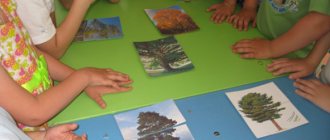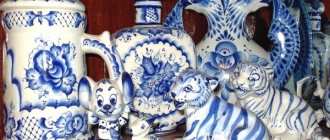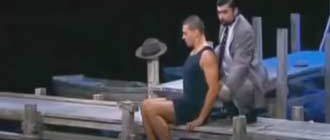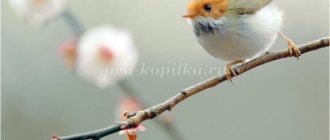Walk “Observing the dog” lesson plan on the world around us (senior group)
Dog Watching Walk
Educational objectives: - systematize ideas about the life of animals in winter; - consolidate knowledge about the dog, its characteristic features, ways of adapting to the environment. Developmental: - develop attention, speech. Educational: - cultivate a sense of responsibility for those who have been tamed. Progress of observation. Educator. Guys, listen to the riddle. She doesn’t speak or sing, but whoever goes to the owner, She lets him know. (Dog.)
The red-haired man walks, drinks from a puddle, and is not afraid of the severe cold. Shaggy tail, black nose.. Who is this?.. Children. Red dog.Teacher.Correct. - Guys, today we are going to watch a dog (Children with a teacher go to the playground.)
And here she is, running towards us. Let’s take a look at her. Which name (nickname) is suitable? (Children's answer.) Girl Masha. This dog constantly comes running to our site when we go for a walk, which means she wants to make friends with us. Let's call her "Buddy"
Educator. We agree, guys. I think we came up with the right name for her. (Children's answer.) Listen to the poem “Dog Buddy” I called the dog “buddy”, And for good reason, not just like that: My dog doesn’t leave me even a step. Suddenly, Buddy will come to want to catch up with himself. That's work, that's work! The tail is close, but you can’t catch it! If someone decides to attack the owner, the Dog will rush to the rescue, growl, bare his mouth. I call him, Buddy! You are my glorious friend, my friend!
Educator. Did you like the poem? - Why did you like it? Let's remember proverbs and sayings.
A dog is man's first friend. The stupid dog barks loudly. With a faithful dog, the watchman sleeps. Every dog wears its own fur. He was a boastful dog, but the wolves ate him. Fear not the dog that barks loudest, but the one that steals away.
Tongue twisters. Our Polkan fell into a trap.
Two puppies, cheek to cheek, nipping at the brush in the corner.
Uncle Kolya gave his daughter Polya a collie puppy, but the collie puppy ran away from Polya into the field.
Educator. Why is a dog a pet? (Children's answer.) Correct. A dog that is adopted into a home recognizes you as its owner. She will be with you everywhere, ready to endure any hardship for your sake. After all, a dog is a devoted friend of man. But we must also remember that we need to take care of her, feed her properly and maintain her. But first of all, you need to love her. Questions: What does a dog eat? What breeds of dogs do you know? What are baby dogs called? How do dogs benefit people? How do dogs prepare for winter? (Children's answer.) Educator. By winter, dogs' fur changes. The summer molts, and the animals become covered with a thicker and darker coat. (Children watch a dog running around the site.) Labor activity. Filling the tree roots in the area with snow. Develop the ability to work together. Research activity: Measure the snow depth with a snow gauge in different places on the site. Determine the condition of the soil in winter.
P/i "Owls" Objectives: - teach to listen carefully to the teacher's command; — develop attention, ensure that the task is completed correctly. Result of the walk. Guys, what did you like most about the walk?
On the topic: methodological developments, presentations and notes
Summary of integrated direct educational and play activities according to the “Childhood” program in the section “The World of Nature” and “The World of Art and Artistic Activities” for children of younger ages.
Goals, plan, lesson notes for introducing fiction, observations, information for parents, poem and story for the dog.
Pet owners often wonder if a cat and a dog can get along together under one roof? After all, these are completely two different creatures, with different views on life, instincts, etc.
Source
Summary of the walk “Observing a cat and a dog”
Alla Yurievna Kotova
Summary of the walk “Observing a cat and a dog”
Purpose of the walk : to continue to expand children’s horizons about the animal world; instill a love for pets; introduce the history of the domestication of dogs by humans ; give an idea of how dogs help a person in life.
During the walk, organize observation of the dog . Please note that the dog must have an owner , he keeps it on a leash.
the dog’s appearance and habits. Find out which of the children has a pet. Tell us about him (his name, breed, habits, favorite food)
.
A teacher's story about the history of the domestication of dogs by humans . “ Dogs are man’s faithful helpers , they help guard the border, save people during fires, live with a visually impaired person (transfer them across the road, help find the way home, dogs are very loyal , smart animals.
Pay attention to the cat and kitten , examine their appearance view. Invite children to tell about their pet. Tell the story of cat : cats have wild relatives - tigers, leopards, lions, cheetahs.
Signs: if the sun rises quickly and shines brightly, the weather will change; The sun sets in the fog - it means rain.
Sayings and proverbs: in October it’s cool and hearty; in October the leaf does not stay on the tree; The geese are flying, dragging their winter fly on their tail.
The living castle grumbled and lay across the door.
Two medals on your chest, better not go into the house! ( dog )
The door opened quietly and a mustachioed beast entered.
He sat down by the stove, squinting his eyes sweetly, and washed himself with his gray paw. ( cat )
Outdoor game "Carousel".
THANK YOU FOR YOUR ATTENTION!
Summary of the walk “Observation of the wind” Observation of inanimate nature - the wind. Goal: to clarify and expand children’s knowledge about air, about the natural phenomenon “wind”, the reasons for its occurrence.
Summary of the walk “Observing the crust” Purpose of the walk: to develop in children the ability to identify the first signs of spring in inanimate nature; continue to introduce the properties of snow; educate. Summary of the walk “Observing the Sun” Purpose of the walk: to give children an understanding of the role of the sun in the life of animals and plants; develop observation skills and the ability to make basic generalizations. "Watching the Sun" Summary of the walk Purpose of the walk: to consolidate children's knowledge that in the spring the sun begins to shine brighter and more often, so it becomes warmer. Tell the children. Summary of the walk “Observing a sparrow” Observing a sparrow. Amazing walkGoal: Continue to expand knowledge about the appearance features, habits of birds, adaptations. Summary of the walk “Observing a grasshopper” Walk. Watching a grasshopper. Goal: 1. Activation of children's recreation. 2. Consolidating the understanding of the world of insects. Tasks: 1. Continue. Summary of the walk “Observing a bumblebee” As you know, a daytime walk before bed consists of three parts - observing something and someone, work assignments and outdoor games.
Source
Preview:
Walk in the second junior group
Purpose: to give an idea about a pet - a dog, to note the features of appearance, behavior, significance in human life, to cultivate a love for animals; talk about taming a dog, about some breeds; encourage children to talk about their pet dogs.
He is friends with the owner and guards the house.
Lives under the porch, and its tail is a ring. (Dog.)
Outdoor game “You, little dog, don’t bark”!
Goal: to teach children to run away, hide in a “house,” and run without bumping into each other.
Low mobility game, round dance “Inflate, my ball”
Goal: to teach children to perform various movements, forming a circle, to practice pronouncing the sound [w].
Didactic game “Who lives in the house?”
Goal: to reinforce the correct pronunciation of sounds. Develop children's speech breathing.
Didactic game “Who is the odd one out.”
Goal: to teach children to choose the odd one out of a number of animals, explain why it is odd; develop logical thinking and attentiveness.
Role-playing game "Atobus"
Goal: development of social behavior, proper communication skills in transport.
consolidate knowledge about where animals and people live.
Work activity: picking up toys before leaving for a walk
Goal: to teach children to maintain order in the kindergarten area.
Lesson summary “Observing a dog”
Oksana Chaukina
Lesson summary “Observing a dog”
Topic: " Watching the dog "
• Clarify children’s knowledge about the appearance of a dog : it has a head, a torso, 4 legs, 1 tail, 2 small ears on its head, two eyes on its muzzle, a nose, and a mouth. The dog's body is covered with soft fluffy fur (black)
.
Introduce children to the habits of a dog : eats meat, laps milk, plays.
• Foster a desire to watch the dog and treat it with care.
•Activation of vocabulary: body, laps, fur, claws (claws, scratches (scratches, chomps, gnaws.
Equipment: dog , basket, 2 pcs. rag napkins, a saucer with meat, water, a round ball for playing, a bone.
Preparing a teacher: preparing equipment, drawing up notes .
Preliminary work: observing the dog on a walk .
Practical part: observing dachshunds
Collecting information about taxes
The main part of the information for creating the project was found on the Internet:
- information about the origin of the breed, that is, in what year and in what place the breed appeared,
- historical facts of the origin of dachshunds,
- there is a huge variety of them.
Additional information was obtained from communication with experienced “avid” hunters living in our region:
- about the behavior of dachshunds;
- their hunting passion in pursuit of prey;
- much more.
And also information is gleaned from the stories of people who keep and care for dachshunds and from personal observations of our pets - dachshunds.
Conducting a survey of classmates on the following questions:
- Do you have pets? Yes or no?
- What kind of pets would you like?
- Would you like to have a pet dachshund dog? Yes or no?
- If you wanted to get a dachshund, why?
- If you didn't want to get a dachshund, why?
- Did you have any pets? Yes or no?
- If so, do they live with you now? Yes or no?
- If they don’t live with you, then why?
Observations of Dachshunds at home
In principle , I have been monitoring the dachshund for a very long time , since she appeared in our house as a small puppy at the age of two weeks.
Our family spent a long time choosing her nickname and finally named her
Dusya . And then a second dachshund, Marusya, - Dusya’s daughter.
They have fun together in our house, they live peacefully. A dachshund puppy doesn't look much like a dachshund. A big belly on short legs, a small face, a hooked nose. At first, while our dachshunds were puppies, we fed them milk and special canned food for puppies.
When they grew up a little, they began to eat cooked food - various porridges made from buckwheat, pearl barley and other cereals. They didn't like the dry food advertised on TV. Most of all they love buckwheat porridge with pieces of liver. But of course, my favorite delicacy is a bone with meat.
Since the dachshund has a natural and irresistible desire to chew on everything that is of some dog interest to it, we now buy two dogs, in addition to toys, special bones. They chew them with great joy.
They often beg for something tasty, especially when they see us eating something. And if you leave food on the table, they can steal a piece while no one is looking. Therefore, you cannot leave food on the table unattended. At first we fed our dachshunds three or four times a day, then when they grew up - twice a day, but now they only have enough to eat once a day, and this does not reduce their energy for playing.
Our dachshund dogs somehow immediately learned to go to the toilet in one place, which was prepared for them in the bathroom. Probably because dachshunds are very smart, clean dogs. During the day and evening, they “beg” - they whine, run up and bark quietly to be taken outside.
Dachshunds have a lot of energy and love to play. The best entertainment for dachshunds is “chasing” and “catching up”. My sister and I often play with them. However, when playing with a dachshund, you need to be careful not to harm the dog's health.
The dachshund is a very loyal dog that loves its owners very much. Our dachshund dogs always enthusiastically greet us when we return from school or work. For joy, they begin to spin and jump, trying to crawl under his arms to be greeted and praised, since they were at home alone and guarded him.
Conclusion
The Dachshund is one of the most beloved breeds around the world. Despite the vagaries of fashion, which, unfortunately, also applies to dogs, the dachshund has been one of the most popular breeds for more than a century.
The dachshund can rightfully be called the most original of all breeds of hunting dogs - quite small in stature and at the same time considerable weight, elongated body and well-coordinated, harmonious movements and, finally, a voice that would be the envy of a larger dog, and teeth and fangs, like all beast dogs are worthy of respect.
Advantages – the dachshund is usually attentive, affectionate and sociable. She has a stable, balanced nervous system, characteristic of dogs of a strong type. The properties of her character, as well as her hunting qualities, provide her with constant sympathy and love. Some people who have never owned a dachshund or interacted with one directly say about these dogs: “I heard that these are the smartest dogs!”
This is probably one of the very rare cases when a rumor can be trusted, when it gives an absolutely correct description of the mental abilities of a dachshund. It is not for nothing that at the beginning of the century Anton Pavlovich Chekhov said about a dog of this breed: “The paws are crooked, the bodies are long, but the mind is extraordinary.” In my opinion, this says it all, this is quite enough to form a first impression about the Dachshund breed. If you decide to purchase a Dachshund, then you need to immediately take into account the risk that everything that comes into his mouth will be tested.
Although it is impossible to remove absolutely all the “forbidden fruits” that excite the dachshund’s imagination, over time it is necessary to begin to instill in the dog a respectful attitude towards the home interior. Therefore, you need to be prepared for the fact that until approximately 8-9 months of age, the puppy will still try to drag something away and chew on it. Many of those who kept dogs of other breeds in their home, but once got a dachshund, will never change it again.
| No. | Parameter | Data | Data |
| 1 | Name | Dusya | Marusya |
| 2 | Color | Black | Redhead |
| 3 | Breed | Dachshund | Dachshund |
| 4 | Age | 6 years | 3 years |
| 5 | Weight | 12 kg | 9 kg |
| 6 | Length | 60cm | 56cm |
| 7 | Temperature | 37,5 | 38,7 |
| 8 | Number of teeth | 42 | 42 |
| 9 | Number of fingers | Front 5, rear - 4 | Front 5, rear - 4 |
References
1. Dachshunds. Story. Exterior. Standards. Tests of Muromtsev M. Year of publication: 2008 Publisher: Aquarium
2. Dachshund Rishina N. Year of publication: 2009 Publisher: Zhuk
3. Dachshund. Standard. Content. Upbringing. Prevention of diseases. Exhibitions Kurt Schmidt-Duisberg Year of publication: 2012 Publisher: Aquarium-Print Series: Pets
4. Dachshund - L.A. Malyshev, I.A. Frolova - publishing house "Kolos" 1993






